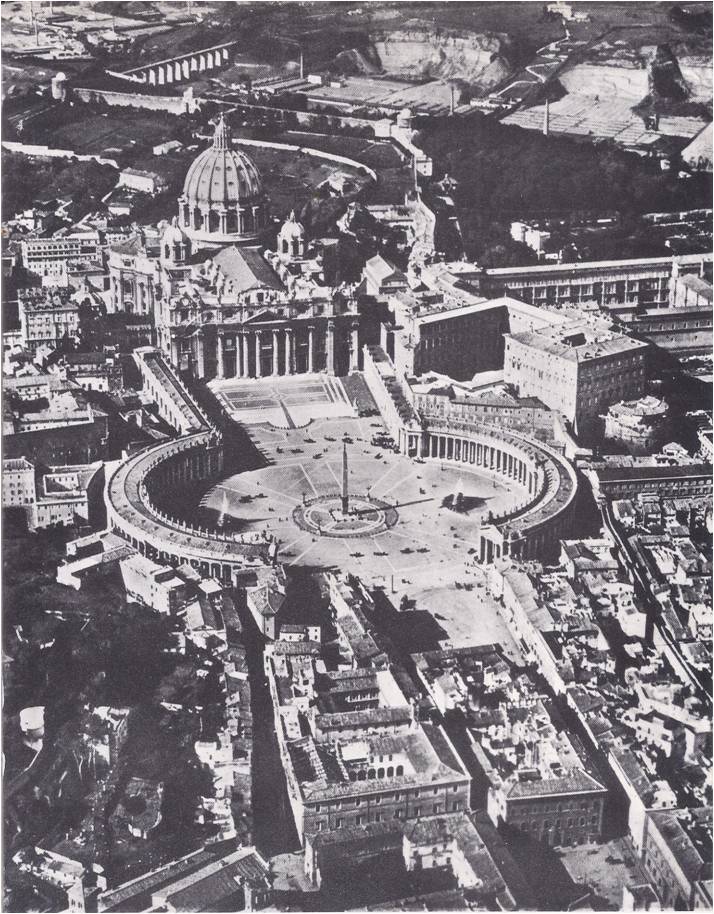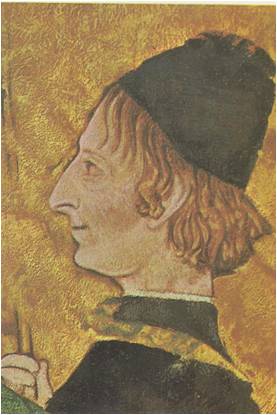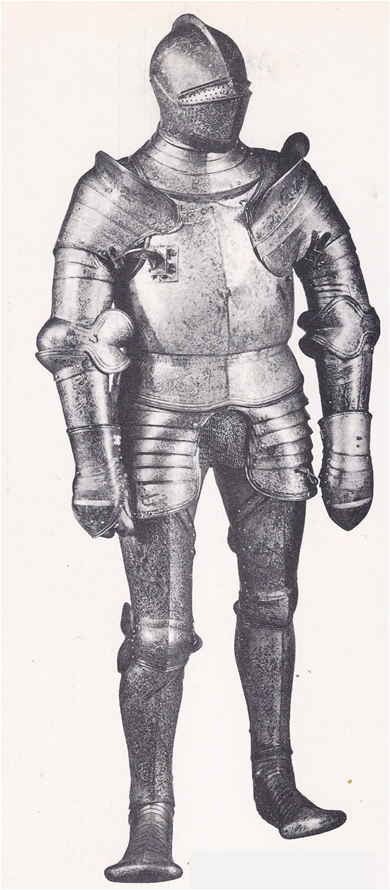Pierre watched the merchant caravan clatter down the narrow dirt road that led through the manor. Pack mules threaded their way to avoid the deep puddles, while the horses strained as they pulled the creaking two wheeled carts. Pierre envied the merchants as well as the sturdy bowmen who guarded the caravan. During his seventeen years Pierre had never been more than a few miles from the manor where he had been born a serf. He was not free to move around as were these merchants who were city folk. Was it true, as Pierre had heard, that a serf who escaped to a town or city and lived there for a year and a day was forever free? He wondered. The merchant caravan disappeared around the bend in the road. Should Pierre follow it? To stay on the manor meant a serf’s life — a life of back-breaking toil. That night after dark, his mind made up, Pierre slipped unseen across the fields and onto a narrow path that led over the surrounding hills. For two nights he walked as rapidly as he could, sleeping fitfully in deep thickets during the daylight hours. Soon after sunrise on the second morning the forest trail led to a wider road, an hour’s journey out of the city of Lacourt. Pierre helped to free an oxcart bogged down in the mire of the roadside ditch and then trudged toward Lacourt in the company of the grateful driver. The young serf’s eyes grew wide with wonder at the unfamiliar sights as he approached the outskirts of the city. Completely encircling it was a wall of stone four times the height of a man. At one point the wall was pierced by a gateway, its great oaken doors swung back. Through the opening Pierre could …
Read More »England’s Elizabeth: Queen of Words and Music 1511 – 1603
In 1600, the Duke Virginio Orsini‚ nephew of the Medici ruler of Florence, arrived in England. He came to spend the New Year’s holidays and to see for himself the woman who fascinated all Europe. She was Elizabeth, queen of England and she was already a legend. To aristocratic travelers, such as the Duke Orsini, she was the most important tourist sight in England. Years later, she would still be as fascinating as any woman in history, for in her time — the Elizabethan Age — her country flourished as never before and the Renaissance blossomed in England. As a girl of twenty-five, Elizabeth had come to the throne of a kingdom torn by religious hatred and civil wars. Her towns were poverty stricken, her farmlands unsown and her army and navy devastated by a series of disastrous foreign wars. Her subjects were weary and confused after years in which short-lived monarchs had alternately honoured and defied the pope and the church of England had split away from the church at Rome. Across the English Channel, the kings of France, Spain and other Catholic nations prepared to attack. They were sure that England, with only a woman to lead it, would soon be easily conquered. THE “FLORENTINE” QUEEN Yet forty years later, when the Duke Orsini came to London, Elizabeth was still queen, the ruler of a kingdom as great as any in Europe. This seeming miracle was the queen’s own doing. “I know I have but the body of a weak and feeble woman,” she had told her people, “but I have the heart and stomach of a king.” She had lived up to her words, for she proved to have the commanding air of her kingly father and grandfather, Henry VIII and Henry VII. England had never known …
Read More »Rome, the City of the Pope 1492-1564
In 1492, young Giovanni de’ Medici bade farewell to his father, Lorenzo the Magnificent and left Florence to take his place in Rome among the cardinals of the church. At sixteen, Giovanni was a nobleman in the court of the pope, a man of influence and power. That was fortunate, for when Giovanni was eighteen, his family’s power collapsed. The Florentines drove the Medici from their city and Giovanni, who had come home for a visit, narrowly escaped being stoned by the citizens who once had cheered him. As he crept out of the city, disguised as a poor friar, he swore that he would one day return in triumph. First, he thought, he must look to his career in the church. Whatever the Florentines did, he was still a cardinal and in the papal court there were many ways for a clever man to rise to greatness. When he had crossed the Tuscan border, Giovanni threw off his humble disguise, put on the crimson robes and red hat that marked him as a “prince of the church” and took the road that led to Rome. The young cardinal was not alone in hoping to make his fortune in Rome. Indeed, the old city teemed with ambitious men of every sort — scholars and scoundrels, diplomats and spies, millionaires and fortune-hunters, priests and professional murderers. Rome had known every sort of splendour and evil. Memories of unmatched elegance and unbelievable cruelty lingered in the ruins of temples and arenas built by ancient emperors. Grim fortress-houses were reminders of an age of violence, when the bloody feuds of rival clans of nobles had turned Rome into a ghost city. Now there were new mansions, palaces and lofty churches. A new magnificence had come to Rome with the gold that poured into …
Read More »Gentlemen, Scholars and Princes 1400 – 1507
One day in the fifteenth century, the Turkish potentate of Babylonia decided to send gifts to the greatest ruler in Italy. He consulted his counselors and men who had traveled widely in Europe, asking them who best deserved this honour. They agreed that one Italian court outshone the rest and that his court must surely be the home of Italy’s mightiest sovereign. They did not name Milan, the home of the proud Sforza, nor Florence, the city of the clever Medici. The most magnificent court in Italy, they said, was at Ferrara, the capital of the dukes whose family name was d’Este and to Ferrara the Turkish potentate’s ambassadors carried the presents. Ferrara was small, a mere toy state in comparison to Milan or Florence. Actually, it was not an independent state at all. Like several of its neighbours in central Italy, Ferrara had for centuries belonged to the Church. Its duke paid an annual tribute to the pope for the privilege of governing his family dukedom himself. Even so, the Turkish potentate’s advisers had made no mistake. No court in Italy could match the splendor of the court commanded by the dukes of little Ferrara. During the Renaissance, there were many such small cities that won fame. It all depended on their rulers — the ambitious dukes or counts or sometimes, commoners who had gained riches and power. With their money, they, too, hired fine artists, sculptors and architects; they, too, collected manuscripts and things of beauty. So the small cities were as much part of the new age as Florence or Milan. In that new age, Ferrara was a place of old fashioned grandeur. Its dukes, the d’Estes, had come to power in the last days of chivalry. In 200 years, the d’Estes had turned Ferrara into a …
Read More »Milan, City of Splendour and War 1277-1515
Milan’s most important business street had no displays of velvet cloaks, bright bolts of silk, or cloth-of-gold. It was a dusty, smoky street, made hot by the fires of forges and filled with the din of hammers shaping steel — the Street of the Armourers. Milan made the finest armour in the world. In the Middle Ages, the crusaders came there for chain mail and it was said that entire armies were outfitted in a few days. Later, the fashions of war changed. Knights wore heavy suits of jointed steel plates that covered them from head to toe and elegant helmets, gilded, engraved and topped with plumes. The Milanese armourers became artists at molding and carving metal, their sales men were welcomed in every court in Europe and the Street of the Armourers became busier than ever. Armour was the right specialty for Milan, for the city and its rulers seemed to specialize in everything warlike and violent. The dukes of Milan were iron-fisted tyrants, who loved displays of splendour and sometimes cruelty. They did not hide their power like the cautious Medici in Florence. Indeed, they made a show of their strength and wealth. It discouraged invaders, rivals and over-ambitious relatives. The dukes’ domain was rich and as large as any state in Italy. The fertile plain of Lombardy, which lay between the Apennine Mountains and the Alps, attracted as many would-be conquerors as farmers. The prosperous little Lombard towns that the dukes overpowered were quarrelsome and the noblemen of Lombardy never stopped stirring up revolts. To hold on to their dukedom, the rulers of Milan employed the toughest warriors in Italy. They frightened their subjects with harsh laws, rewarded them with pageants and impressed them with magnificent palaces. Splendour, fear and power — these were the specialties of …
Read More »Florence in the Golden Age 1469 -1498
Lorenzo de’ Medici was far from handsome. His skin was sallow, his eyes had a short-sighted squint and his nose was flat and wide. His voice was high and thin. Like every man in his family, he had the gout. Yet there was grandeur in everything Lorenzo did. He loved art and books, music and poetry and women. He delighted in sports, hunting and galloping across the brown Tuscan hills. He dealt with ambassadors like a prince, his palace was the gathering-place for the great men of Italy and his city won renown for both its scholars and its carnivals. No wonder, then, that people called him Lorenzo the Magnificent. Visitors to Lorenzo’s city found the streets jammed with people, and marveled at the splendid buildings. There were hundreds of shops and houses, dozens of churches and palaces. Even the bridges over the River Arno were lined with little stores and homes. The busiest spot in all the bustling city was the Mercato Vecchio, or the Old Market. This was the gathering-place of shopkeepers, the men who were the smocks and fur caps that marked them as members of the lesser guilds. Here were the grocers with their little booths, the butchers, the fishmongers, the apothecaries and the barbers, who shaved their customers in the midst of the crowd. The most important businessmen met in another square, the Mercato Nuovo, or the New Market. It was not as noisy here and most of the men were dressed in the long dark gowns and bright hoods of the merchants. In the shops and under awnings, the guildsmen displayed the goods they sold to all of Europe — richly dyed wool and Silk, velvet, taffeta, damask, satin and cloth-of-gold. Just off the New Market was the street of the grain-dealers and not …
Read More »Florence, First City of the Renaissance 1200-1480
March 25, 1436, was the Feast of the Annunciation and the city of Florence was decked out for a celebration. Banners flew everywhere, ribbons and garlands of flowers decorated the houses and draperies of cloth-of-gold were looped across the shop-fronts. The city bustled with excitement, for on this Annunciation Day the pope was to dedicate the Duomo, the wonderful new Cathedral of Santa Maria del Fiore, then the largest church in the world. At dawn, the people began to fill the streets. They crowded around the high wooden walk that led to the cathedral from the monastery where the pope was staying. At mid-morning, when a blare of trumpets signaled the start of the ceremonies, a great procession filed along the walk. The pope, robed in white and crowned with a tiara, was attended by seven cardinals, clothed in scarlet and 37 bishops and archbishops, all in purple. There were the priors, the governors of Florence and the representatives of the people of sixteen districts of the city. Each representative carried a standard marked with the emblem of his district, such as the lion, the unicorn, or the viper. Marching in a solemn line came the leaders of the seven great guilds — the wool merchants, the Silk weavers, the bankers, the notaries, the druggists (who also dealt in spices and jewels), the furriers and the calimala, the ancient and honoured guild of cloth merchants. Behind them came the officers of fourteen “Guilds of Lesser Arts” shoemakers, bakers, innkeepers, grocers, carpenters and the like. As the procession entered the cathedral, all the church bells in Florence rang out. Their deep voices called across the city, resounded in the fields beyond and echoed in the hills of Tuscany. Triumphantly they proclaimed the greatness of the new Duomo that the Florentines said …
Read More »






